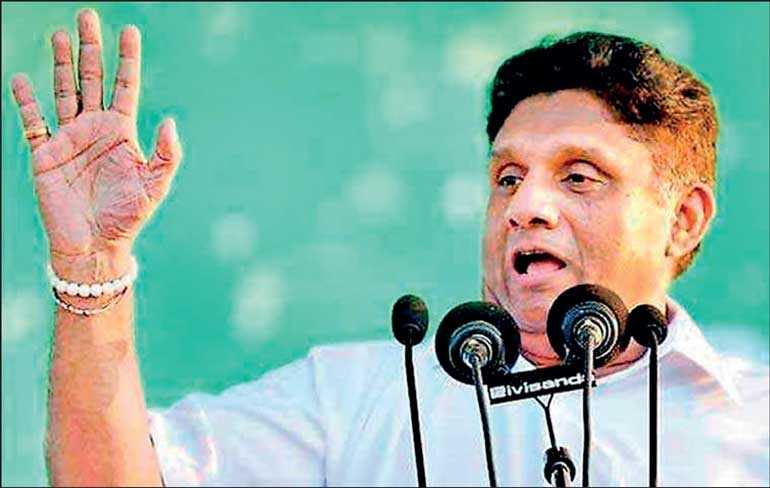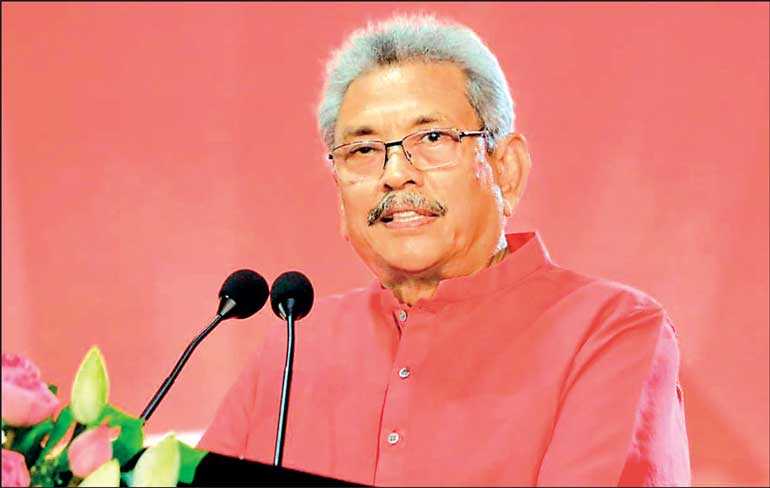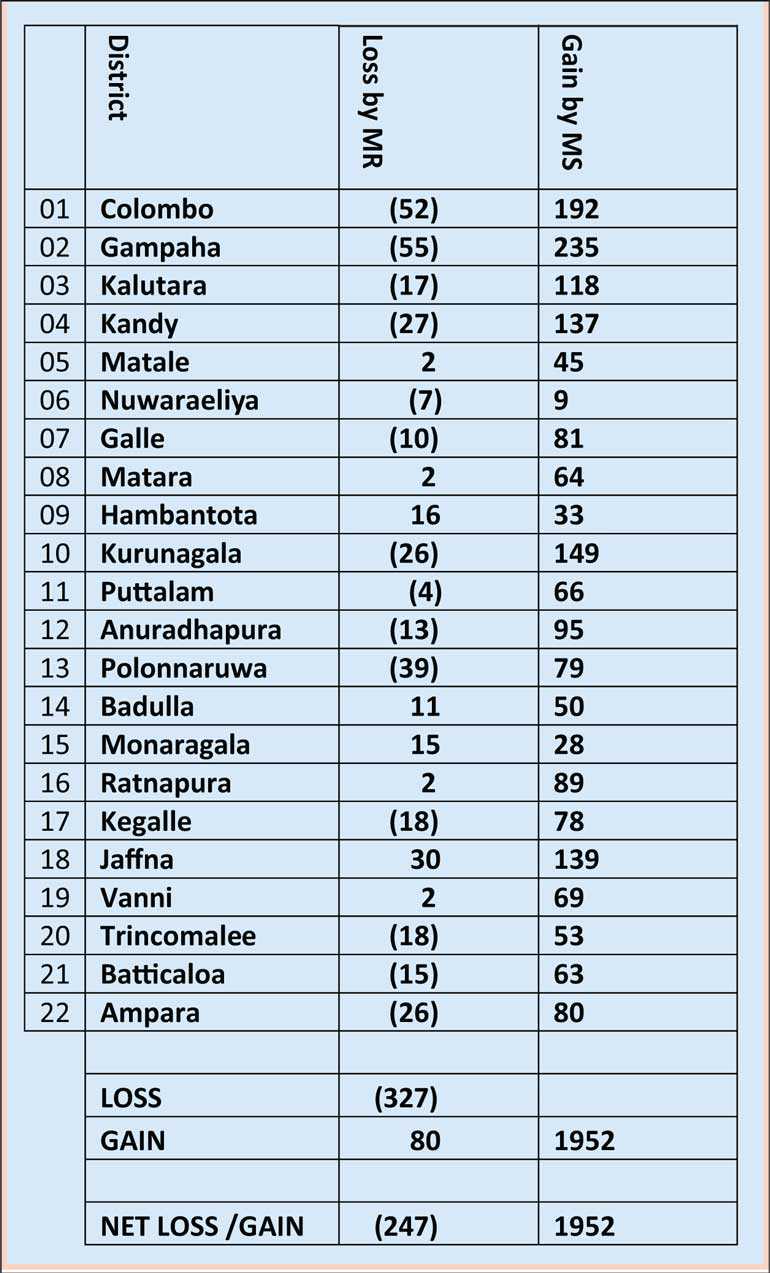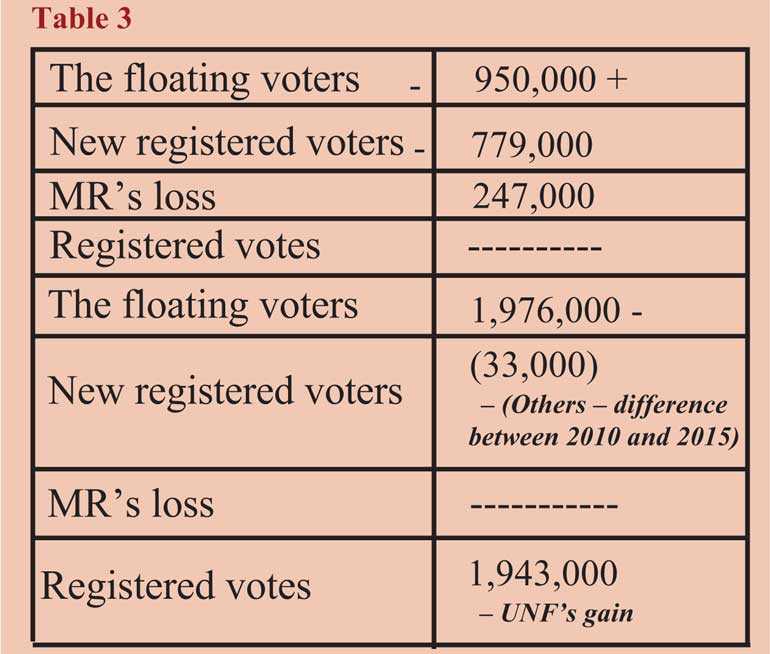Thursday Jan 08, 2026
Thursday Jan 08, 2026
Friday, 1 November 2019 00:00 - - {{hitsCtrl.values.hits}}





By V.K. Vethody
Mahinda Rajapaksa (MR) was defeated by Maithripala Sirisena (MS) in the 2014 Presidential Election. It was a bit of an unexpected defeat considering the fact that the difference between MR and UNF in the 2010 election was quite substantial with a majority of 1,843,000, which was a solid 18% of the total valid  votes.
votes.
Nonetheless in the 2014 election MS not only managed to overcome this deficit but also gained a net majority of 449,000 votes. This was possible due to a combination of MR’s losses plus the additional polling. Table 1 shows the district wise loss of MR and gain of MS.
According to table 1, MR lost 327,000 votes in 11 districts while gaining 80,000 votes from the remaining 11 districts. The net loss, therefore, was 247,000 votes (2% of the valid voters), which is not pertinently substantial as the majority of MR in the 2010 election was 1,843,000. In other words MR managed to hold on to 98% of his bloc vote.
MS, on the other hand, had a net gain of 1,943,000 over and above UNF’s 2010 vote base of 4,173,000 resulting in 6,217,000 total votes with a net majority of 449,000. This increase was13% of the total number of registered voters of 15,044,000 and 16% of the total valid votes of 1, 2123,000. MS’s gain was from each and every district. In this context it should be noted that the number of registered voters in 2014 was 15,044,000 while in 2010 it was 14,088,000. And the polling in 2014 was a record of 81.52% while in 2010 it was only 74.5%. Therefore, MS’s net gain of 1,943,000 votes can be arithmetically reconciled as seen in table 2.
Therefore, the additional votes polled during 2014 was 1,729,000 (the difference between the two valid votes - 12,123,000 minus 10,394,000 = 1,729,000). This figure is also inclusive of 956,000 newly registered voters. Assuming that 81.52% of these voters (polling was 81.52%) voted, then the increase equalled = 779,000 new voters. The balance 950,000 (1,729,000 minus 779,000) is those who did not vote during the 2010 elections, and who can be considered as the floating voters.
Therefore the UNF gain of 1,943,000 is arithmetically accounted as seen in table 3.
Though one cannot conclude that the entire 779,000 new voters voted in favour of the UNF, since the newly registered young voters are mostly anti-establishment, especially whenever there is a strong anti-incumbency prevailing, and as MR manged to hold on to his vote bank, and also as this figure correctly fits in to fill the gap within the UNF gain, it can be safely assumed that the new voters were part of the floating voters, who voted to change the incumbent government.
Political analysis of this 1,943,000 voters
Since MR more or less managed to hold on to his vote bank and MS gained 1,943,000 votes without any specific political identity, from nowhere, this bloc can safely be assumed as floating voters. These voters do consider themselves as educated or pretend to be educated intelligent voters, and in the normal political circumstances they are quixotically guided by the core values of ‘Nationalism’ and ‘Good Governance’ in terms of the rule of law, accountability and transparency. Since they consider themselves as “intelligent” (pandithaya) voters they do not tolerate any insult to that “intelligence” in any form of ‘political arrogance’ on the part of the ruling dispensation.
Out of this bloc, however, the 324,000 votes (17% of MS’s total gain) were from the five North East districts. These voters cannot be strictly considered as floating voters in a collective sense as they are not strictly guided by the overall ‘collective national and governance values’. Their voting priorities are completely different from the priorities of the majority Sinhalese areas. Therefore, the floating voters who mattered during the 2014 election were 1,619,000 voters (1,943,000 minus 324,000), which is 15% of the total valid votes in the majority Sinhalese districts. This figure is inclusive of the newly registered voters as well. Therefore, the damage for MR was done in the majority Sinhalese districts.
As these so-called floating voters are guided by the core values of ‘Nationalism and Good Governance’ they always look for an optimum balance between ‘Nationalism’ and ‘Good Governance’. Thus whenever this balance gets distorted, as very often has happened in the Sri Lankan context, these voters do get confused and get divided or abstain from voting. However, in an extreme scenario, where one factor totally dominates the other, these voters do react and come out en bloc and vote to change the then dispensation - provided there is an acceptable alternative.
In 2014 this is what led to MR’s fall. In 2014, the dominant political issue was ‘Political Arrogance’, though the then dispensation made a desperate effort to mask it with the virtues of an exaggerated version of Nationalism. The alternative presented was MS, who appeared from nowhere as a simple, humble, grass-root, well-articulated Sinhala Buddhist, who was attired in the famous ‘Modi’s vest’. The imagination of the so-called floating (pandithaya) voters got tickled.
They were mystified with his political Dhamma Desana that was filled with attractive bubbly assurances on ‘Nationalism and Good Governance’, which he branded as ‘Yahapalanaya’. The Yahapalana bubbles were further multiplied by the cacophony of foreign-funded NGO noises. The pandithaya voters were securely carried away. They felt even more secure when the Yahapalana bubbles were further culturally and spiritually endorsed by Sobitha Thero and many other Theros, while the Yahapalana mahathayas were successful in portraying then incumbent government as a family hegemony, corrupt, intolerant of other religions, war criminals, godfathers of drug mafia, politically arrogant and a government not accepted by the so-called ‘pro-Tamil Diaspora International Community’.
The so-called quixotic floating voters were activated. They voted en-bloc adding on to the Yahapalana blocs of votes of Mano Ganeshan, Digambaram, Rishad Badurudeen, Rauf Hakim, TNA, JHU, JVP, UNP and the SLFP remnants, in spite of the fact that the entire Yahapalana team appeared like an unpalatable achcharu. MR, the National Hero, who liberated the bleeding Paradise from the clutches of 30 years of war, fell – and MS won.
2019 election – Based on 2015 results
If the present political context continues to sustain, and if the arithmetic of the Sri Lankan ‘bloc-politics’ continues to hold, Gotabaya Rajapaksa’s (GR) victory in the forthcoming election is a foregone conclusion.
It should be noted that GR’s greatest asset in this election is MR’s more or less solid vote bank, which is a pan-Sinhala uniform vote bank of around 48% of the valid votes (2014 Presidential Election), which is almost 65% of the total Sinhala votes. This is only 2% short of the magical figure of 50% and 4% less than the Yahapalana vote, which is made up of various bloc votes of all sorts of Yahapalana alliance partners. As the difference is only less than 4%, any one of the major alliance partners shifting towards GR or a combination of two or more moving out or even a small percentage of 2-4% peel away from the Yahapalana blocks would ensure the defeat of the Yahapalanists.
It should be noted that the JVP, who had polled 5% in the 2016 Parliamentary election and 6% in the 2018 Local Council election, had already moved out of the Yahapalana camp, and this has more or less arithmetically reduced the Yahapalanists to 46%, which is 4% less than the 50% level and 2% less than MR’s bloc vote.
Due to the strong anti-incumbency sentiment prevailing against the Yahapalanists, there is also a strong possibility of some anti-incumbent voters may emerge from the Yahapalana blocs themselves and get peeled away either into GR’s kitty or abstain from polling. Even if it is at a minor scale, since it is from various diversified blocs of voters, it is going to be detrimental for Yahapalanists and beneficial for GR as the difference in 2014 is only marginal. Following are some groups that are speculated to be some-what vulnerable to peel off, at a minor as well as major scale, from the Yahapalana kitty.
Muslims: Some elements of scepticism regarding the hypocrisy of the conspiratorial manipulation of communal enmity between the Sinhalese and the Muslims by a couple of Yahapalana leaders seem to have set in among some sections of the Muslims, after the Ampara and Digana anti-Muslim riots. Some of them even began to unequivocally question the consequences attached to the conspicuous Islamic political identity, which created an Islamophobia among the majority community. This confusion was aggravated into a collective sense of insecurity after the Easter bombings. Therefore, the Muslims may not be as cohesive as they were during the 2014 election. There may be minor leakages of votes to GR’s kitty though most of them would still vote for Yahapalanists, as their identity in the Parliament is dependent on UNF to some extent. However, no noticeable increase from the 2014 level is expected in favour of the Yahapalanists from this vote bank as they had already voted en bloc against MR.
Indian Tamils: The majority of them are ideologically inclined towards the UNP. Therefore, almost all of them, except hard-core supporters of Thondaman and perhaps miniscule sections of the business community, would vote for Yahapalanists, as they did in 2014.
JHU: strength cannot be quantified here as they have been contesting in alliance with MR since 2005 and in 2014 with the Yahapalanaya. However, considering that the gross vote lost by MR in 2014 was only 327,000, which could be a collective combination of MS’s SLFP supporters, JHU voters, and some of the floating voters who would have voted for MR during 2010 in appreciation of war victory, it can be assumed that the JHU’s contribution to the Yahapalana kitty was quite negligent. This was quite evident in the last Local Council election during which the Yahapalanists heavily lost all their supposed strongholds. Even those negligent voters are vulnerable to a shift as they are supposedly hard core nationalistic Buddhist voters.
UNP bloc vote: It is a myth of past glory. The UNF vote at its peak in 2014 was 52%. Once the floating voters (15%), JVP (5%) and TNA (5%) are removed from this 52% it becomes only 27% to the credit of the UNP, SLMC, ACMC, Mano Ganeshan and Digambaram. This 27% more or less corroborates with their 29% in the 2018 Local Council election and 24% in the Elpitiya election. As there is a huge anti-incumbency sentiment against the Yahapalanists, a noticeable level of shift either to GR’s camp or to abstention, is possible from this vote bank, as happened in Elpitiya. This might push Yahapalanists into a pathetic situation.
North-East Tamils: According to the circumstantial evidences, the TNA, the political alliance that represents almost 50 to 60 % of the voters in the North-East, does not seem to be comfortable with a ‘formal Yahapalana alliance’ unlike in 2014, as their leaders publicly pronounce their unhappiness about the unfulfilled promises of the Yahapalana government. They even push the Yahapalanists into a politically dilemmatic situation by imposing 13 demands like a Federal Constitution with self-determination right, International Criminal Court powers, North East merger, etc., which can be accepted only at the cost of the Sinhalese voters. It should be noted that these 13 demands are only a reiteration of the same demands that were pledged by the TNA in their manifesto during the 2015 Parliamentary election, and as such TNA itself admits to the fact that none of their promises are fulfilled in spite of the unstinted support (even to the extent of saving the government at couple of occasions) extended to the Yahapalanists throughout the last four years and nine months. Nevertheless the TNA being the TNA, as they do not have a better option and as they might succumb to international pressure, they might opt for a tacit understanding with Yahapalanists and mobilise their voters in favour of them. However, to what extent this would be acceptable among some of their own partners (like TELO, PLOT and EPRLF) can be assessed only once the election results are declared. Nevertheless, the absence of a formal alliance and ‘the unfulfilled-promises-syndrome’, and most importantly the explicit inflexibility shown by the present Yahapalana leaders in accepting any of those TNA demands would adversely affect Yahapalanists in terms of reduced polling among the North-East Tamils.
Majority vs. minority: Generally there is a perception that the minorities, en bloc would vote for the Yahapalanists. If that theory holds true then it can be assumed that the UNF bloc vote in the majority Sinhalese districts is inclusive of the minorities living in those areas. This is true to a major extent because for the last many years the minority parties, except in very few minor aberrations, have been piggy-riding on the UNF to reach the Parliament or Provincial Councils. The only exception is Thondaman with his much-reduced vote bank aligning with MR. Therefore the votes from the minority dominated North East districts become important. In this context, it should be noted that the total number of Registered Voters in the five North East Districts are only 2,030,000 which is only 13% of the total vote. Out of this the average valid votes in these districts were 71% during 2014 as well as in 2018 elections, out of which MR had a share of 25%, and the balance 75% were for the Yahapalanists.
If these figures hold true for the forthcoming elections the Yahapalanists can expect 1,080,000 votes from these districts, which is only 7% of the total national registered voters and 9% of the total national valid votes. For arguments sake, even if we presume that the polling in these districts goes up to the national level of 81%, out of which Yahapalanists gets 80% (to be more optimistic), their votes from these districts go up to 1,315,000 - an additional gain of 1% of the national valid votes to their kitty, which will take them to 39% (29% +10%) at the national level without the floating voters. However to gain this 10%, the Yahapalanists may have to do a lot of minority appeasement - to be more specific TNA appeasement - by sacrificing a certain percentage of the Sinhalese votes, especially the floating voters. It should be noted that 1% vote in the majority Sinhalese districts is equivalent to 139,620 votes. In other words 1% of the votes in the majority Sinhalese districts is equivalent to 7% of the votes in the North East districts. In this sort of a scenario, appeasing the TNA or for that matter even the Muslim parties in the context of a strong ‘Islamophobia’, with the objective of maximising their votes from the North East districts would be disastrous for the Yahapalanists, as the Sinhalese are famous for wild swings in elections as seen during 2014, where the Yahapalanists managed to increase their votes by more than 50% from 40 % to 62%, even on a higher polling. Therefore, for the Yahapalanists to survive, at least to show some decent defeat, the floating voters along with the 948,000 new voters become very vital. But the question is during the last four years and nine months whether the Yahapalanists were successful in placating the core values of ‘Good Governance and Nationalism’, the values that the floating as well as the young voters adore.
Floating voters: Unfortunately for the Yahapalanists, though the ‘Yahapalana bubbles’ floated all over during the 2014 election time, the bubbles began to fizzle one after another as the Yahapalana regime perceivably failed in many aspects of governance. Nationalism from the point of view of the nationalistic Sinhala floating voters became a humiliation of their collective psyche like with the formalisation of the Tamil National Anthem; the co-sponsoring of the UN resolution; the threat of the prosecution of soldiers for war crimes by international investigators, prosecutors and jury; the threat of the International Criminal Court; the fear of a NGO-TNA driven Federal Constitution; the arrests of soldiers, intelligence officers and Buddhist priests; the eagerness to sign the ACSA and SOFA agreements; unwinding of the intelligence machinery; the conspicuous emergence of Islamic Fundamentalism under the callous eyes of the Yahapalanists and the consequent emergence of ‘Islamophobia’; the Easter bombings and the consequent exposure of the callous attitude towards national security by the Yahapalanists by accusing each other without being accountable; detection of Islamic arms, ammunitions, explosives and swords from all over Sri Lanka; and most importantly the fear of the re-emergence of the LTTE in the context of the raids on the LTTE den in Malaysia, detection of arms and explosives from the north and moreover the 13 demands placed by the Tamil parties, while our sovereignty was being violated by certain diplomatic missions, NGOs and international civil servants. There go the floating voters, who voted in the spirit of nationalism out of the Yahapalana kitty.
It is not only nationalism, but ‘Good Governance’ also became a joke with the Yahapalanist’s insensitive attitude towards the public like with the suspension of all the Chinese-backed infrastructure projects and the renegotiation and re-awarding of the same projects to the same companies with worse terms and conditions with malicious intent; sale of the Hambantota harbour, which was earlier ‘yahapalanistically’ portrayed as a failed project where no ships can get in; converting Mattala Airport into a paddy warehouse and reconverting it back into an airport with the intention of selling it; appointing Sambandan as the Leader of the Opposition; the looting of the Central Bank not once but twice; motivated attempts by certain UNP MPs to whitewash the Central Bank looting; alleged massive scale of blatant corruption in almost all the Ministries as revealed by the Committee On Public Enterprises and Commissions appointed by the President; widespread drug menace; crony capitalism like in the case of the Volkswagen factory and loans and grants to the crony tycoons; the 19th Amendment, which created two power centres and made governance complicated; Wilpattu clearance; shooting and killing on the streets like we see in Bollywood films; postponing elections; burden of innumerable taxes at various points making the businesses as well as the common man struggle; public display of communal animosities on archaeological and religious sites; chaotic government departments, strikes, demonstrations and traffic jams; pathetic economic growth of 2.6%, which is even lesser than Afghanistan; and moreover the comical democratic display of ‘Yahapalana dramas’ in the Parliament and perennial power struggle between the President and the Prime Minister.
The Yahapalanists, by all means, compromised national security, economy, political stability and the sovereignty. Anti-incumbency against the Yahapalanaya is, therefore, very strong, and as such the floating voters, who voted for the Yahapalanaya in 2014, do not seem to be motivated like in 2014. The shift of this bloc either en-bloc or even partly to GR would make a huge difference. Even the abstention by this group would ensure a comfortable majority for GR.
The other vulnerable group is the additional new 948,000 young voters. Out of this 160,000 are from the north east, which is 17% of the total increase. Majority of this 160,000 are not expected to vote for GR. The rest, 788,000 voters in total, however, are vulnerable as they are usually anti-establishment and behave like seasoned floating voters.
Finally, a new group that might emerge in favour of GR is the frustrated Catholic vote bank, who heavily voted for Yahapalanaya in 2014.
Therefore, based on 2014 results as well as the present political circumstance, it is almost impossible for the Yahapalanists to come back to power.
Projection – based on 2018 Local Council election
This is simply based on the electoral arithmetic that had taken place during the 2018 Local Council election. This can be reasonably accurate as it was the most recent election conducted, and the polling was 80% almost closer to the 81.5% of the 2014 election. Following are the votes received by various parties.
Actual votes received by the Yahapalanists: UNP – 3,640,000 + TNA – 338,000 + Other Tamil Parties – 250,000 + SLMC – 92,000 + ACMC – 85,000 = 4,405,000. It should be noted that some areas SLMC contested with UNP.
Actual votes received by SLPP and Allies: SLPP – 5,006,000 + another 78,000 (Maharagama and Elpitiya) + CWC – 50,000 + EPDP – 74,000 = 5,208,000. It should be noted that the CWC contested with the UPFA in several areas.
Votes received by the UPFA – 1,500,000; JVP – 710,000; Independents – 329,000.
It should be noted that the difference between the SLPP and the Yahapalanists is only 803,000 votes. Therefore, the votes received by the UPFA and the Independents becomes crucial. However, since the UPFA voters are very strong anti-UNP voters, as unanimously pronounced by the UPFA leaders, the chances of the majority of those voters voting for GR is very high. Therefore, on a conservative line, if this vote is split two-third (i.e. 1,000,000) and one-third (i.e. 500,000) in favour of the SLPP and the Yahapalanists respectively, and if the independents split 50-50 (meaning 164,500 each), GR will get a comfortable majority.
That means: 5,208,000 + 1,000,000 + 164,500 = 6,372,500, which will be 49.4% of the possible polling of 12,953,000 on 81% polling on 15,992,000 registered voters in 2019, which will be slightly short of 50% mark.
On the other hand for the Yahapalanists: 4,405,000 + 500,000 + 164,500 = 5,069,500, which will be 40% of the polled vote, JVP will be 4%, and the others could be 2 to 3%. This means there is 5% additional votes for grab in the forthcoming election. So if GR grabs 20% of this 5%, he crosses the magical 50% mark. This majority for GR could even be higher considering the fact that the Easter bomb blast took place after this election and consequently a fear psychosis overwhelmed the nation. Moreover the political situation was further deteriorated as the Yahapalanists exposed themselves by accusing each other without being accountable for the national security disaster. Depending on the decision taken by the TNA and the intensity of the confusion among the north east voters the difference between GR and the Yahapalanists can further get widened.
However, the Yahapalanists are confident that Sajith Premadasa’s candidature will be helpful not only to hold on to their entire blocs of votes of 2014, but also for realignment of social engineering and generate new class of voters even from MR’s camp in favour of SP, though this attempt of social engineering does not seem to be working so far, as shown by the Elpitiya Pradeshiya Sabha election. The Yahapalanists, on the other hand, could not even hold on to their vote bank in spite of all the governmental pampering of the voters. Their vote bank was further reduced to 24% in Elpitiya.
Therefore, considering the 2014 and 2018 election results and the present political circumstances, the Yahapalanists can win only - if there is very strong social engineering in terms of class equations that precipitates in the majority Sinhalese districts as the Yahapalanists are wishing for in the context of Sajith’s candidature or if the entire voters who voted for Yahapalana in 2014 once again vote for Yahapalana along with the entire new voters. This seems to be a herculean task. Moreover looks like one of those farfetched theoretical hallucinations of those Western-educated NGO-oriented professors.